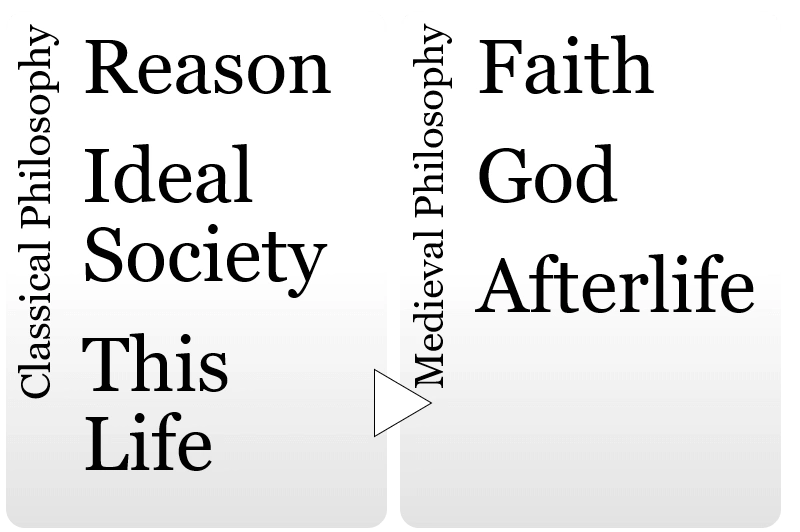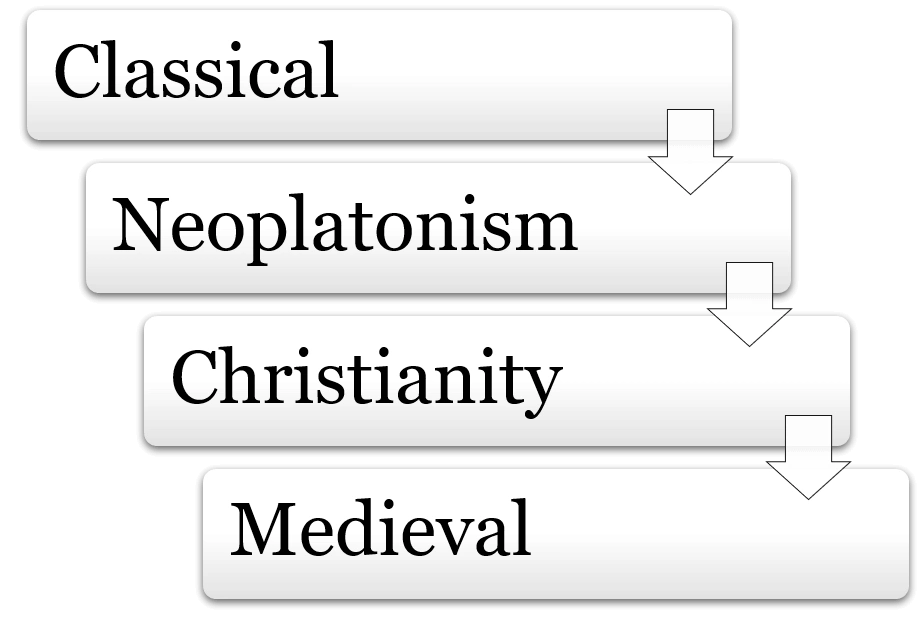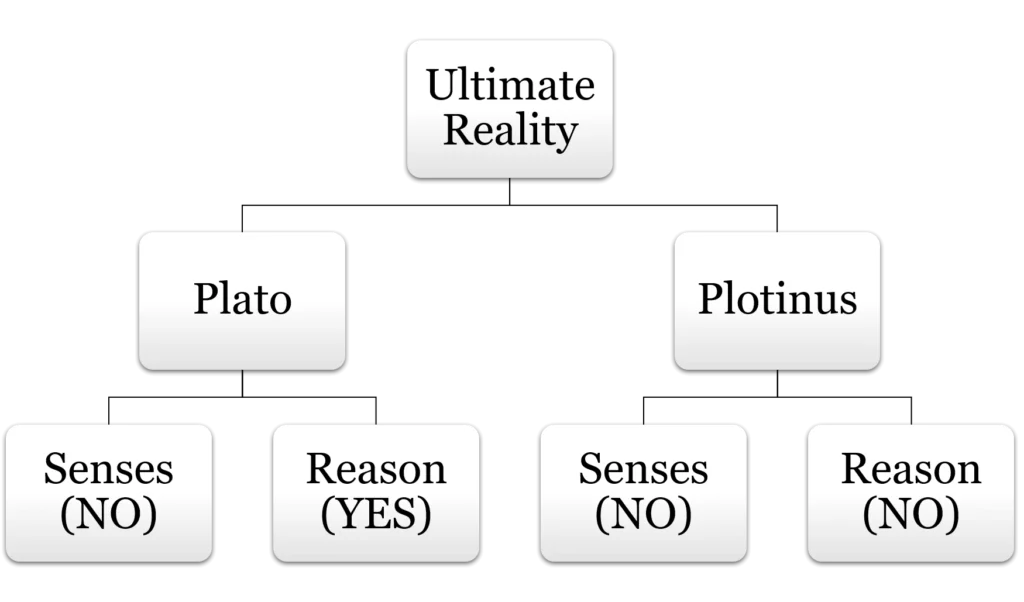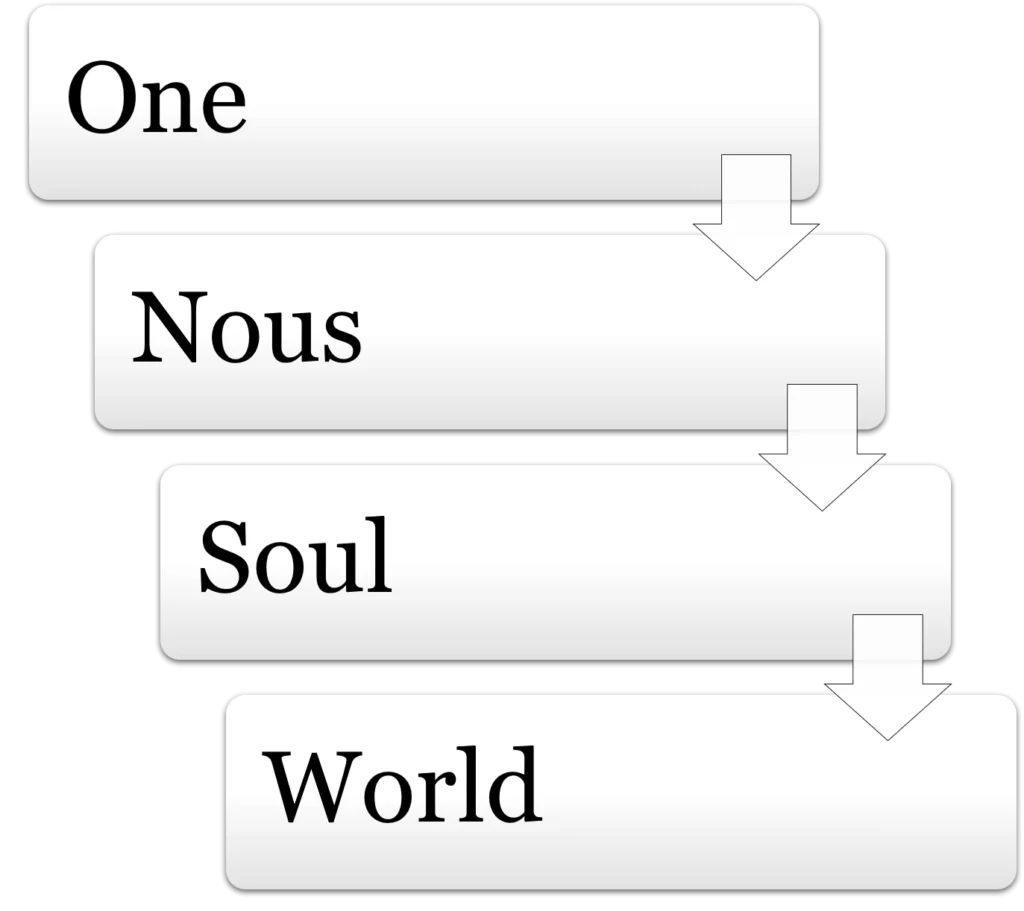Learn Neoplatonism and Plotinus in simple words. These notes explain The One, Nous, Soul, emanation, problem of evil, and how Neoplatonism shaped Christianity and medieval philosophy. Perfect for quick revision.
Table of Contents:

The Shift from Classical to Medieval Philosophy
- Neoplatonism appears in the final stage of Greek philosophy.
- After this, the Christian era begins and dominates for nearly 1200 years.
- Classical philosophy focused on reason, intelligence, and living a good life in this world.
- Medieval philosophy shifts the focus to life after death, salvation, and God.
- Earlier philosophers like Plato and Aristotle discussed ideal states and societies. Now, the concern is about eternal life and faith.
- Greek thought started by questioning mythology and religion through reason, but ends by turning back towards religion and theology.
- Ethics and politics give way to theology (study of God).
- Faith becomes more important than reason, as people believe only God can save them.
Summary:
Greek philosophy begins with reason and ends by returning to religion. Neoplatonism marks the turning point where focus moves from this life to the afterlife, from ethics and politics to theology and faith. This shift opens the door to medieval philosophy and Christianity.

Slow Transition
- The change from classical to medieval philosophy happened slowly, not suddenly.
- Early signs of this shift appear in the philosophy of Marcus Aurelius, but become stronger after his time.
- The main goal is to understand how Neoplatonism shaped this transition and how Christianity entered this framework.
- Christianity later becomes the center of medieval philosophy.
- Before fully entering Christianity, it is important to understand its philosophical foundation.
- In Rome, Christianity was not entirely new—there were many mystery cults (local religious groups) with ideas similar to Christian beliefs.
- Three such cults will be discussed to see how they influenced the rise of Christianity.
Summary:
The move from classical to medieval philosophy was gradual, beginning with hints in Stoic thinkers like Marcus Aurelius. Neoplatonism and mystery cults prepared the ground for Christianity, which later became the heart of medieval philosophy.
The Great Mother Cult
- A famous mystery cult in Rome was dedicated to the Goddess Cybele (the Great Mother).
- Cybele’s lover Attis dies, causing darkness, famine, and destruction in the world.
- Later, Attis is brought back to life, restoring joy and fertility to the earth.
- This story was reenacted as a ritual drama, first for good harvests but later for spiritual hope.
- Followers believed that joining this cult could make them immortal like Attis.
- Rituals included fasting, self-punishment, and Taurobolium (a bull sacrifice ritual).
- In Taurobolium, the blood of a sacrificed bull was poured over a person, symbolizing spiritual purification and new birth.
- After purification, the believer was considered free of sins and promised eternal life after death.
Summary:
The cult of the Great Mother (Cybele) used myths and rituals like Attis’ resurrection and the blood purification ceremony to promise followers eternal life. This belief in spiritual rebirth strongly influenced later religious traditions.
The Great Mother and Christianity
| Cybele’s Cult | Christianity |
| Cybele’s cult is 1000+ years older | Christianity came later in Rome |
| Attis dies and is reborn | Jesus dies and resurrects |
| Purification through blood (Taurobolium) | Purification through water (Baptism) |
| Ritual promises new birth & eternal life | Baptism symbolizes new birth & eternal life |
- The Cybele cult is nearly 1000 years older than Christianity and already existed in Rome.
- Like Attis, Jesus also dies and is resurrected, giving hope of eternal life.
- In Cybele’s cult, blood purification symbolized rebirth; in Christianity, baptism with water serves the same role.
- Both traditions teach that sins are removed and a believer begins a new spiritual life in the community.
- Cybele (also called Kubileya) is the goddess of mountains, shown with a lion. Similarly, Hindu goddess Parvati is linked to mountains and also shown with a lion.
- Ancient religions worldwide show common symbols and stories, like branches of a tree leading back to the same root.
- These similarities provide context for the shift from classical to medieval philosophy, and for the role of Neoplatonism in the development of Christianity.
Summary:
The Cybele cult shares striking similarities with Christianity, such as resurrection and purification rituals. These ancient religious patterns show how Christianity grew within a cultural environment already rich with symbolic traditions, shaping the transition into medieval philosophy.
The Egyptian Cult of Osiris
- In Egypt, a famous myth was about Osiris, Set, Isis, and Horus.
- Set kills his brother Osiris, who was seen as a just king or even a god.
- Osiris’ wife Isis brings him back to life.
- From this union, she conceives a son Horus, who later takes revenge on Set and restores order in Egypt.
- This myth of death and rebirth is around 3000 years older than Christianity.
- The story was also known in Rome and shows the idea of life after death.
Summary:
The Egyptian story of Osiris, Isis, and Horus highlights the themes of death, resurrection, and justice. These ideas existed long before Christianity and influenced religious thought in the ancient world.
The Persian Cult of Mithra
- Mithra was a Persian god worshipped for eternal life and salvation.
- The belief system explained the world as a struggle between two powers: Good and Evil.
- Good brings order and peace; Evil brings chaos and war.
- The human soul becomes polluted when it travels through seven planets to reach Earth.
- Life on Earth is a test: if the soul chooses goodness, it returns to heaven; if not, it is punished in hell forever.
- Mithra guides humans to do good and protects them from evil.
- After death, Mithra judges each soul and decides reward or punishment.
Summary:
Mithraism taught that life is a test between good and evil. The soul must choose goodness to return to heaven, with Mithra guiding, judging, and rewarding his followers.
Rituals and Beliefs in Mithraism
- Becoming a member of the Mithra cult was a slow and difficult process, requiring seven stages of initiation.
- Mithra was associated with the sun, symbolizing light, purity, and life.
- Worship was done three times daily (morning, noon, evening) based on the sun’s position.
- The seventh day of the week was considered sacred.
- The main festival was on 25th December, celebrating the rebirth of the sun after winter.
- Christianity shares similar ideas:
- Struggle between God and Satan (Good vs Evil).
- Judgment after death (Heaven or Hell).
- Jesus’ birth celebrated on 25th December, just like Mithra’s sun-birth festival.
- Mithraism is linked not only to Zoroastrianism but also has connections with the Vedas, where a god named Mitra appears, associated with the sun.
| Mithraism | Christianity |
| Mithra guides humans, judges after death | God/Christ judges souls after death |
| Entry required passing seven stages | Entry through faith and baptism |
| Mithra linked with the Sun (life, purity) | Jesus called “Light of the World” |
| Worshipped 3 times daily; 7th day holy | Prayer traditions, Sunday holy day |
| Major festival: 25 Dec, rebirth of Sun | Christmas: 25 Dec, birth of Jesus |
| Struggle of Good vs Evil | Struggle of God vs Satan |
| Connected to Zoroastrianism & Vedic Mitra | Connected to Jewish roots, spread in Rome |
Summary:
Mithraism shared many similarities with Christianity, including the struggle of good and evil, judgment after death, and the 25th December festival. Its roots in Persia and possible links to the Vedas show how interconnected ancient religions were.
Roman Republic vs Roman Empire
- In the Roman Republic (till 27 BC), power was shared among elected leaders, and decisions were made through discussion and voting.
- In the Roman Empire (from 27 BC onward), Emperor Augustus took complete control, and all power was centralized in one ruler.
- Mystery cults like Cybele, Osiris, and Mithra were opposed during the Republic but slowly gained acceptance under the Empire.
- Roman history shows how religion and politics were deeply connected to the structure of power.
Summary:
The shift from the Roman Republic to the Roman Empire gave more space for mystery cults to grow. Under one powerful emperor, these personal religions spread, preparing the ground for Christianity.
Roman Gods vs Mystery Cult Gods
- Roman state gods:
- Protected the city and state.
- Maintained political systems, military power, and social order.
- Focused on this-worldly concerns.
- Mystery cult gods:
- Focused on the individual, not the city.
- Promised guidance, protection, and eternal life after death.
- Concerned with the other world beyond death.
Summary:
Roman state gods supported society and politics, while mystery cult gods promised personal salvation and eternal life. This difference made the cults attractive to people seeking spiritual hope beyond politics.
Decline of the Roman Empire After Marcus Aurelius
- The Roman Empire remained strong under the Five Good Emperors (Nerva to Marcus Aurelius), lasting about 90 stable years.
- After Marcus Aurelius’ death in 180 AD, his son Commodus became emperor. He was corrupt and irresponsible.
- This marked the beginning of decline for the empire.
- Following Commodus, weak emperors and constant civil wars weakened Rome.
- The empire faced invasions, economic collapse, social disorder, and political corruption.
- Writers of the time described the world as if it was “growing old”—with fading sunlight, dying farmers, corrupt markets, and lost justice.
Summary:
The death of Marcus Aurelius began Rome’s downfall. With corrupt rulers, civil wars, and economic collapse, the empire weakened. This decline created fertile ground for new religions like Christianity to spread hope.
Psychological Shift in the Roman Empire
- As the Roman Empire declined, people felt helpless, weak, and out of control.
- A distant emperor’s orders could change lives, but citizens had no power to question him.
- Corruption and collapse made people lose hope in society.
- When life feels out of control, people naturally turn from community gods to personal gods who promise protection and salvation.
- This shift was like being in a burning building—people stopped thinking about saving society and prayed only for their own survival.
Summary:
The collapse of the Roman Empire created a psychological shift. People lost faith in city gods and turned to mystery gods who promised personal safety and eternal life.
Stoicism and the Search for Control
- Plato and Aristotle taught that a good life is possible only in a good society.
- When society collapsed, people turned to philosophies like Epicureanism and Stoicism, which focused on the individual.
- Stoics taught the dichotomy of control:
- Some things are under our control (our judgments, reactions, choices).
- Some things are not under our control (external events, politics, others’ actions).
- True peace comes from focusing only on what is in our control.
- Stoicism becomes popular when people feel powerless in society—just as it did in Rome and as it does again today.
Summary:
Stoicism gave people strength during times of crisis by teaching them to focus only on what they can control. It helped individuals stay calm and virtuous even when society was falling apart.
State Religion to Personal Salvation
- In Rome’s democracy, people trusted the state and focused on building an ideal society.
- When the empire collapsed, that trust was lost.
- People stopped relying on city gods and started seeking personal gods who promised salvation.
- Focus shifted from improving this world to finding hope in the next world after death.
- Even today, people who feel hopeless in life often turn to spirituality or search for experiences beyond this world.
Summary:
As Rome declined, people abandoned city gods and turned to mystery religions that offered personal salvation and eternal life. The focus moved from society to the individual, and from this world to the afterlife.
Neoplatonism: A New Phase in Philosophy
- In the 3rd century, philosophy and religion came closer together.
- A new philosophical school developed, later called Neoplatonism.
- Neoplatonism was not a religion, but a philosophical system.
- It aimed to solve the difficulties in Plato’s Theory of Forms.
- Plato himself admitted that his theory had some problems.
- Aristotle, Stoics, and others had already tried different solutions.
- Neoplatonism offered a unique reinterpretation of Plato’s ideas.
- In this process, it developed into a kind of philosophy of religion.
- Neoplatonism strongly influenced both Christianity and medieval philosophy.
- It also reshaped how later generations understood Plato.
Summary:
Neoplatonism emerged in the 3rd century as a reinterpretation of Plato’s ideas. It bridged philosophy and religion, shaped Christian thought, and had a lasting influence on medieval philosophy and our understanding of Plato.

Transcendence and Anti-Rationalism
- Neoplatonists highlighted two main points in Plato’s philosophy:
- Transcendence – Ultimate reality is beyond our senses.
- Plato divided reality into two levels:
- The physical world (experienced through senses).
- The world of forms (eternal and unchanging, beyond senses).
- The physical world is only a shadow of the real world of forms.
- Plato divided reality into two levels:
- Anti-rationalism – Even reason cannot fully grasp ultimate reality.
- Plato suggested that refined reasoning (dialectic) might reach the forms.
- Neoplatonists stressed instead that reason is also limited.
- Transcendence – Ultimate reality is beyond our senses.
- Like the Skeptics, they argued that reason cannot reach truth, but they took this idea further.
Summary:
Neoplatonism emphasized that true reality is both beyond the senses and beyond reason. This created a shift toward the idea that philosophy alone cannot reveal ultimate truth.
Suprarational Method and Mystical Union
- Skeptics solved the limits of reason by using probability—accepting what seems to work.
- Neoplatonists rejected this, because people wanted certainty, not probability, in times of crisis.
- They developed the idea of a suprarational method:
- Reality is beyond senses, language, and reason.
- Truth can only be reached through mystical union with the ultimate reality.
- This mystical vision is described as:
- Going beyond subject and object.
- Merging with the ultimate reality like a river flowing into the ocean.
- Something inexpressible in words, but still considered a “direct experience.”
- Neoplatonism shifted focus from ethics and politics to religion and mystical experience.
Summary:
Neoplatonists argued that ultimate truth is beyond both senses and reason. Instead of relying on logic, they taught that mystical union with reality is the only way to achieve certainty. This marked a major shift from ethics and politics to religion and spirituality.
Life of Plotinus
- Plotinus (204–270 CE) is the founder of Neoplatonism and the most important philosopher of this period.
- He was born in Egypt and studied in Alexandria, which was a major center of education.
- Dissatisfied with many teachers, he became a student of Ammonius Saccas for 11 years.
- Ammonius Saccas had knowledge of Greek, Persian, and Indian philosophy.
- Inspired by Eastern thought, Plotinus tried to travel to Persia and India to meet philosophers there.
- He joined Roman Emperor Gordian’s army hoping to reach the East, but Gordian was killed in battle.
- Plotinus escaped and settled in Rome, where he spent the rest of his life teaching and forming a community.
Summary:
Plotinus, founder of Neoplatonism, studied under Ammonius Saccas and was deeply influenced by Greek, Persian, and Indian ideas. After failing to reach the East, he settled in Rome and became a major philosophical and spiritual teacher.
Plotinus as a Teacher and Philosopher in Rome
- In Rome, Plotinus quickly became famous as both a philosopher and a spiritual guide.
- People from all walks of life—doctors, senators, poets, and even emperors—came to him.
- He was known for his kindness, poor health, and care for orphans (sometimes even housing them).
- He never married or celebrated his birthday.
- His classes were discussion-based, usually starting with Plato or Aristotle’s writings, highlighting their problems, and then presenting his own solutions.
- In the last 15 years of his life, he wrote down his teachings, which were later compiled by his student Porphyry.
Summary:
Plotinus became a respected teacher in Rome, known for his kindness and discussion-based teaching. His student Porphyry later preserved his writings, ensuring his lasting influence.
Plotinus’ Writings: The Enneads
- Plotinus’ writings were compiled by his student Porphyry into a work called The Enneads.
- “Enneads” means groups of nine.
- The work is divided into six treatises in each group, covering topics from ethics and the physical world to soul and God.
- The complete work is about 900 pages long and can be difficult to read, requiring repeated study.
- Recommended resources:
- Cambridge edition of The Enneads – clear, modern, with an excellent introduction to Plotinus’ life and philosophy.
- The Essence of Plotinus – a more accessible book summarizing his main ideas.
Summary:
Plotinus’ philosophy is preserved in The Enneads, a collection of writings compiled by Porphyry. Though challenging, modern editions and summaries make his thought more accessible to students today.
Neoplatonism as a Philosophy of Religion
- Neoplatonism is called a philosophy of religion because:
- It is a philosophical system based on Plato’s metaphysics.
- It also shows a religious approach to connect with ultimate reality.
- Plotinus called ultimate reality “The One”, similar to Plato’s Form of the Good.
- For Plato, reality could be approached through dialectic (reasoning).
- Plotinus pushed further, insisting that senses and reason are not enough.
- Ultimate reality can only be known through a suprarational mystical experience.
Summary:
Neoplatonism combined philosophy and religion by reinterpreting Plato’s ideas. Plotinus taught that “The One” can only be reached through mystical union, beyond senses and reason.
The Concept of “The One”
- Plotinus described ultimate reality as The One.
- The One is:
- Beyond thought and language—it cannot be captured in words.
- Absolute unity—the more real something is, the more unified it is.
- Perfect and independent, not bound by space or time.
- Omnipresent, yet beyond physical existence.
- The One cannot be defined; it can only be described by what it is not.
- Humans can prepare themselves for mystical vision, but the experience comes like a sunrise—unexpected and beyond control.
Summary:
For Plotinus, the highest reality is “The One,” a perfect unity beyond space, time, thought, and language. It can only be approached through mystical preparation, not rational explanation.
Knowledge, Limits of Thought, and Mystical Vision
- All knowledge is conditioned by hidden assumptions.
- What we call “knowledge” is mostly opinion, not absolute truth.
- To reach absolute knowledge, we must see the limits of reason.
- Plato’s dialectic was about a higher kind of thinking.
- Plotinus reinterpreted dialectic as a mystical vision:
- No premises, no conclusions, no logical steps.
- A direct, non-conceptual awareness of truth.
- For Plotinus, reason is powerful but limited. True reality lies beyond both senses and reason.
Summary:
Plotinus argued that reason and senses cannot reach ultimate reality. Instead, he emphasized mystical vision—a direct awareness of truth beyond logic and language.
Plotinus’ Mystical Experience and Its Problem
- Plotinus’ student Porphyry reported that Plotinus had four mystical experiences in six years.
- In these moments, he felt union with the ultimate reality and expressed his philosophy based on them.
- Problem: Mystical experiences are private.
- No matter how real they feel, they cannot be shared or proven.
- A philosophy built on them may be impossible to fully understand without having the same experience.
- Even if we read all of Neoplatonism, the central mystical core may remain inaccessible to us.
Summary:
Plotinus’ philosophy was shaped by his private mystical experiences. While powerful, these experiences cannot be directly communicated, making Neoplatonism difficult to fully grasp.
Concept of Emanation: From The One to the World

- Plotinus compared The One to Plato’s Form of the Good—the ultimate source of everything.
- The One does not “create” like a craftsman; instead, everything flows (emanates) from it naturally.
- This process is like light flowing from the sun—effortless and automatic.
- The chain of emanation is:
- The One – the highest principle, perfect unity.
- Nous (Intellect or Mind) – arises from The One, contemplates it, and produces perfect forms.
- Soul – flows from Nous, and through it the material world comes into being.
- In Nous, the perfect Forms exist—like Plato’s forms of Beauty, Justice, or Tree.
Summary:
Plotinus explained reality as an overflow from The One. Through emanation, Nous (Mind) and Soul arise, leading to the physical world. The One is the ultimate source of all existence.
Emanation vs Creation
- Unlike Plato’s demiurge (craftsman) who builds the world, Plotinus’ One does not “create.”
- The One is not a being in space or time.
- The One does not perform an action; instead, emanation is its natural state of perfection.
- Example: a mirror reflects an image without effort or movement. Similarly, The One’s perfection overflows into Nous and Soul.
Summary:
For Plotinus, the world does not come from an active creator but from The One’s perfection naturally overflowing. Emanation is effortless, like a mirror reflecting or the sun giving light.
Analogy of Self-Awareness and the Birth of Nous
- Plotinus used analogies to explain how Nous emanates from The One.
- Example:
- A person in deep sleep is unaware of their existence.
- On waking, self-awareness arises: “I exist.”
- This awareness gives rise to thought, ego, and identity.
- Similarly, when The One becomes self-aware, Nous (Mind) emanates from it.
- Nous thinks only about The One’s perfection and beauty, and in this process produces the Forms.
- Plotinus wrote in Enneads that when The One “sees itself,” intelligence emanates.
- Here “seeing” means self-awareness, not physical sight.
Summary:
Plotinus explained emanation through self-awareness: just as waking brings self-consciousness, The One’s awareness produces Nous. From Nous come the Forms and the structure of reality.
Nous: Unity and Diversity
- Plotinus taught that Nous (Intellect/Mind) is the true first principle in action, even though it comes from The One.
- Nous is a unity but generates many forms and ideas.
- Example: one mind can create many different and opposite thoughts, yet it remains one.
- The One provides the ground for Nous:
- By contemplating The One, Nous produces diversity (the Forms).
- But because of its source in The One, Nous remains unified.
- Nous has two functions:
- Contemplating The One (its source).
- Contemplating the Forms it generates.
- Nous is like a storehouse of eternal ideas (Platonic Forms), which exist perfectly and permanently.
- Plotinus’ metaphysics explains not only the physical world but also the spiritual world.
Summary:
Plotinus saw Nous as the first principle that balances unity and diversity. By contemplating The One, it generates eternal forms, serving as the foundation of both physical and spiritual reality.
Soul: Bridge Between Nous and the World
- From Nous, the Soul emanates.
- In Nous, ideas exist like seeds, and these give essence to the Soul.
- The Soul has a creative power that shapes the material world.
- Functions of the Soul:
- Contemplating Nous and its perfect forms.
- Shaping matter into the physical world, like an engineer builds using a blueprint.
- Matter:
- Always existed, but it is formless and passive.
- The Soul gives it form and order.
- Two parts of the Soul:
- Upper part – always remains pure, connected to Nous and The One.
- Lower part – enters the material world and risks corruption.
- When involved with matter, the Soul forgets its divine origin.
- Example: like a shepherd wandering so far that he forgets his home.
- In truth, there is only one universal Soul shared by all humans and animals, though bodies make it appear divided.
Summary:
Plotinus explained the Soul as a bridge between Nous and the material world. While its upper part stays connected to divine reality, its lower part risks corruption by matter. Ultimately, all souls are one, despite appearing separate in different bodies.
Matter: Intelligible and Sensible
- Plotinus distinguished between two types of matter:
- Intelligible matter – provides the foundation for the Forms (ideas) in Nous.
- Sensible matter – provides the foundation for the physical world.
- Sensible matter is a copy of intelligible matter, just like Plato said the physical world is a copy of the world of Forms.
- In Plotinus’ philosophy, matter is puzzling:
- It has always existed.
- It is like non-being, described as darkness or shadow.
- It is hard to define clearly.
- Many Neoplatonist ideas—like emanation, one soul in many bodies, or matter as shadow—are difficult to fully grasp.
Summary:
Plotinus described matter as twofold—intelligible and sensible. Sensible matter is a shadow or copy of intelligible matter, but the concept remains mysterious and hard to define.
The Goal of the Soul
- Human souls originate from The One through Nous and Soul.
- The process: The One → Nous → Soul → Physical World.
- Souls become trapped in the material world and forget their divine source.
- The true goal of every soul is to return and merge with The One (God).
- What looks like many individual souls is really one universal soul divided into many bodies.
Summary:
According to Plotinus, each soul comes from The One but becomes entangled in matter. The true purpose of life is for the soul to rise above the material world and unite again with its divine source.

How the Soul Can Rise Back to The One (Virtue & Reincarnation)
- Main problem: the soul becomes stuck in the material world and must return to The One (its true home).
- Virtuous life is one practical method: moral living weakens attachment to matter.
- Plotinus accepts reincarnation — souls are reborn; a virtuous life leads to a higher rebirth.
- If a person chases only bodily pleasures, the soul becomes more attached to matter and falls lower.
- Animals follow body-needs; humans can rise above physical desires by ethical living.
- Gradual purification through virtue reduces the soul’s cycles of birth and death.
Summary:
Plotinus teaches that living a moral, disciplined life purifies the soul. Over many lives this lifts the soul away from material pull and closer to The One.
Mystical Vision and Contemplation: A Faster Way to Union
- An alternative (faster) route is a mystical vision — a direct, suprarational experience of The One.
- This vision cannot be forced; you prepare yourself but cannot guarantee it will occur.
- Preparation includes deep contemplation of nature and beauty (not scientific study but meditative looking).
- By seeing inner beauty in nature and in yourself, you trace that beauty back to its divine source.
- You must detach from the body: avoid senses, desires, and anything that pulls you toward mortality.
- Focus on the soul (your real self) rather than the body to open to the divine light within.
Summary:
Mystical vision gives quick union with The One, but it is unpredictable. Deep meditation on beauty and firm detachment from bodily desires help prepare the soul for this experience.
Virtue and Inner Work: The Sculptor Analogy
- Contemplation (inner seeing) and moral effort (virtue) support each other.
- Plotinus compares self-improvement to a sculptor: remove rough parts to reveal the beauty inside.
- If you cannot yet see inner beauty, work on yourself to become beautiful (ethical training, remove faults).
- This inner crafting polishes the soul and makes mystical insight more possible.
Summary:
Plotinus says work on your character like a sculptor: remove faults and reveal your inner beauty. Moral practice and meditation together help the soul return to its source.
Purification, Solitude, and Dialectic: Practical Steps
- Purification means letting the soul clear itself by removing distractions.
- Plotinus recommends solitude: a quiet, undisturbed mind where thoughts settle.
- Analogy: muddy water left alone will clear as the dirt settles — the soul becomes clear if not stirred by sense-desires.
- Meditation here often means “do nothing” and allow clarity to arise naturally.
- He also recommends philosophical dialectic — an advanced, disciplined thinking that helps clear false assumptions and prepares the mind theoretically.
- The soul is originally pure; it becomes polluted by matter. Purification restores its original, divine nature.
Summary:
To return to The One, Plotinus advises solitude and inner stillness so the soul can purify itself. Dialectic (deep, disciplined thought) complements meditation and moral effort to remove the coverings of matter.
The Problem of Evil
- A key challenge: If everything comes from The One (God), why is there evil in the world?
- Plotinus’ answer:
- Evil does not come from The One, Nous, or Soul.
- Evil arises when the Soul comes into contact with matter.
- Matter corrupts whatever it touches, so it is the source of evil.
- But matter is not a positive reality — it is a kind of non-being.
- Analogy of light and darkness:
- Light is brightest at its source (The One).
- It grows dimmer at the levels of Nous and Soul.
- Beyond Soul, light disappears — this absence is darkness (matter).
- Darkness is not something real; it is the absence of light (goodness).
Summary:
For Plotinus, evil comes from matter, which is not real in itself but the absence of goodness. Just as darkness is nothing but the lack of light, matter represents distance from The One, and this absence gives rise to corruption and evil.
Importance of Plotinus and Neoplatonism
- Plotinus is a central philosopher who shaped the transition from classical to medieval thought.
- Skipping him when studying medieval philosophy is like leaving a major gap in philosophy’s history.
- Although Plotinus said reason is not enough to reach ultimate reality, his writings use rigorous logic and careful definitions.
- His work:
- Defines terms precisely.
- Relates ideas systematically.
- Provides evidence for claims.
- His style is dense and difficult, and his writings were not well-arranged, leading to misunderstandings.
- Many scholars stop at Stoicism and ignore him, but this distorts the picture of philosophy.
- Christian philosophy borrowed many ideas, concepts, and even language from Neoplatonism — which may also explain why Plotinus is often overlooked.
Summary:
Plotinus is essential for understanding the bridge between Greek philosophy and Christianity. His rigorous but difficult writings influenced medieval thought deeply. Ignoring him leaves a serious gap in studying philosophy’s development.

Leave a Reply